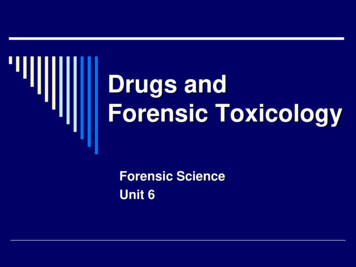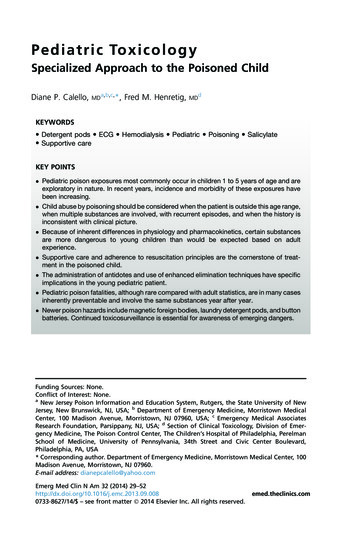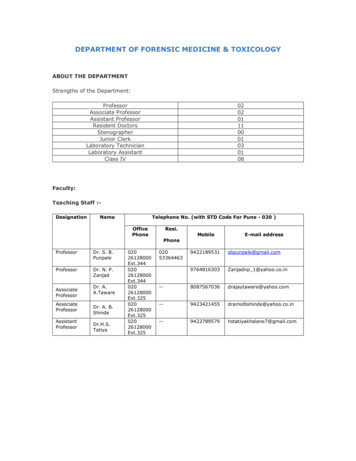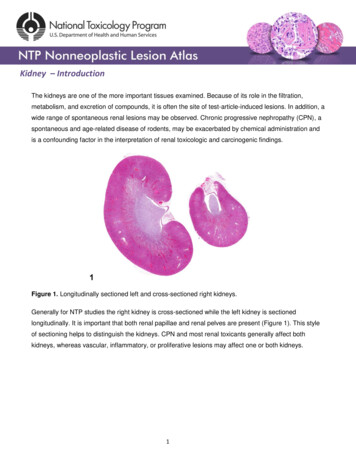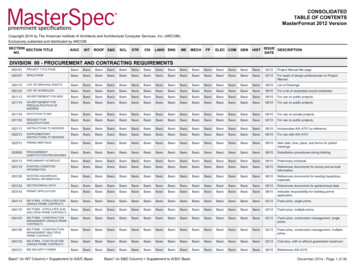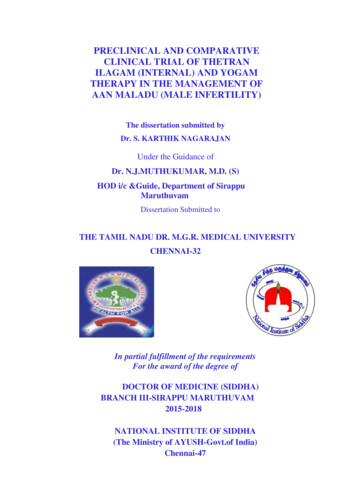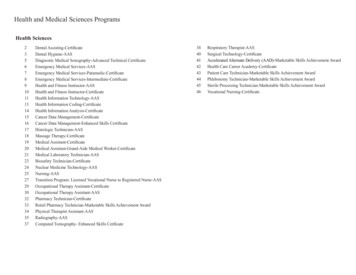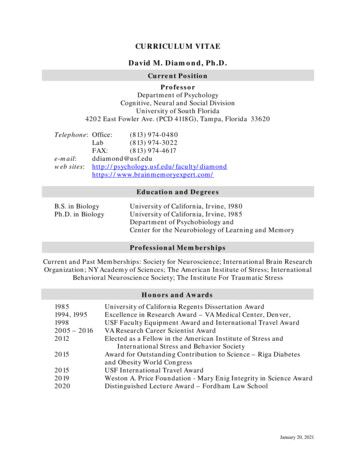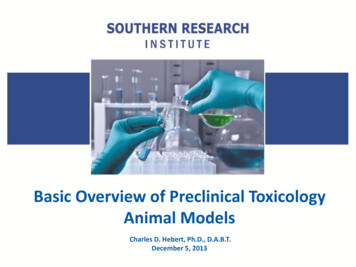
Transcription
Basic Overview of Preclinical ToxicologyAnimal ModelsCharles D. Hebert, Ph.D., D.A.B.T.December 5, 2013
Outline Background In Vitro Toxicology In Vivo Toxicology Animal Models
Background What is Toxicology?– Toxicology is the study ofthe adverse effects ofchemical, physical, orbiological agents onpeople, animals, and theenvironment.– Toxicologists arescientists trained toinvestigate, interpret andcommunicate the natureof those effects.“Solely the dose determinesthat a thing is not a poison.”Paracelsus (German-Swissphysician), 1493-1541.Water, in excess, is toxic.
Why Do Toxicology TestingNeed to prove new drugs are safe: Before first administration to humans Before later clinical trials
Good Laboratory Practices Regulations to ensure the integrity of data fromnonclinical studies. In the USA, the GLPs are administered by theFDA, and are laid out in 21CFR Part 58 Other regulatory agencies (OECD, EPA) havetheir own sets of GLP regulations that are similarto but not identical to those of the FDA. Definitive preclinical studies must be GLPcompliant
In Vitro Toxicology In vitro toxicology– The crossover point between drug discovery and drugdevelopment.– Provide information on mechanism(s) of action of a drug– Provides an early indication of the potential for somekinds of toxic effects, allowing a decision to terminate adevelopment program before spending too much money. In vitro methods are widely used for:– Screening and ranking chemicals– Studying cell, tissue, or target specific effects– Improve subsequent study design
In Vitro Toxicology In vitro methods are usually– Less expensive to run than in vivo studies– Faster than in vivo studies (PLUS they don’t bite!)– Somewhat less predictive of toxicity in intact organisms
In Vitro Toxicology Screening––––––CytotoxicityProtein bindingCYP inhibition/inductionMembrane permeabilityMetabolic stabilityInterspecies comparison
In Vitro ToxicologyCytotoxicity Cytotoxicity toxicity to cells Many different types of cells can be used; cellsfrom higher organisms (e.g., liver cells, bloodcells); bacteria; fungi; yeast Can be used to assess viability, structural effects,and/or function– Structural – e.g., effects on membrane integrity– Functional – e.g., effects on mitochondrial function– Cell proliferation – decreases or increases
In Vitro ToxicologyDermal or Ocular Toxicity Replace in vivo tests such as Dermal Corrosion, SkinIrritation, Draize Eye Irritancy Many tests now available in kit form Example: EpiDerm––––Normal human epidermal keratinocytesCultured on a permeable polycarbonate membraneStratified, highly differentiated, model of human epidermisMetabolically and mitotically active cells organized intodifferentiated layers
In Vitro ToxicologyImmunotoxicity These are, by necessity, functional tests Examples– Cytokine release. Assess ability of a chemical to inducerelease of cytokines/chemokines. Can use cells fromvarious sources, including peripheral blood cells. Manyvariations of this assay. TGN 1412– Drug-induced histamine release. Cremophor, polysorbate80
In Vitro ToxicologyMetabolism and Kinetics Assess ability of a chemical to induce metabolism ofspecific substrates, including the chemical itself Information about metabolic pathways by which thechemical can be metabolized Information on production of toxic/reactivemetabolites Interspecies comparisons– Can provide information on relevance of a particular animalmodel from a metabolic standpoint
In Vivo Toxicology - Purpose Results from preclinical toxicology studies should,at a minimum:– Establish a safe starting dose for clinical studies– Provide information on a drug-treatment regimenthat would produce the least toxicity– Assess target organ toxicity and its reversibility– Provide insight into biomarkers for clinicalmonitoring
Safety AssessmentTypes of Testing Required Single dose (acute) toxicology testing– Combine with preliminary testing Repeat dose toxicology testing– The “pivotal” testing Toxicokinetic and pharmacokinetic studies– Next lecture Safety Pharmacology– CV, respiratory and CNS– Stand alone studies or combine with toxicology? Local tolerance testing– Parenteral– Stand alone studies or combine with toxicology? Genotoxicity testing
Types of Preclinical Safety Studies The number and types of studies required depend onthe therapeutic indication. Drugs for life-threatening illnesses require fewerstudies to reach the clinic. In general, animal studies are conducted in twospecies, one rodent (e.g., rat, mouse) and one nonrodent (e.g., dog, nonhuman primate). Biologics mayrequire only one species. Other species (e.g., rabbits, ferrets, hamsters, minipigs) may be used for special studies (e.g., vaccinestudies).
Types of Preclinical Safety StudiesUsually start with:Single Dose (Acute/Range-Finding) Used to determine the most appropriate dose rangein the species to be tested. Used to get an idea of target organs Includes minimal number of animals and evaluations(e.g., body weights, clinical signs of toxicity) Usually not required to be GLP-compliant
Types of Preclinical Safety Studies Repeat Dose Toxicity Animal models Small molecules – two species (one rodent, one non-rodent) Biologics – may require only one species if only one relevantspecies can be identified Should mimic as closely as possible the planned clinicaldesign Route Duration Schedule Requirements vary between the different regulatoryagencies.
Types of Preclinical Safety Studies Repeat Dose Toxicity Extensive evaluations of toxic effects Body weightsClinical signs of toxicityFood consumptionClinical pathologyHistopathologyOther Large animals usually undergo more extensive evaluation(e.g., ECGs) At least one dose should produce dose-limiting toxicity. At least one dose should be non-toxic.
Types of Preclinical Safety Studies Safety Pharmacology Used to determine the effects of the drug on specializedorgan systems (e.g., cardiovascular, respiratory,neurologic) Chronic Toxicity/Carcinogenicity Used to determine the effects of long-term exposure to thedrug, including the ability to produce cancer. May not be required for drugs that are intended for onlyshort-term use (e.g., antibiotics) and that are expected tohave no permanent effects on DNA. Reproductive Toxicity/Teratogenicity Evaluates effects on reproductive function and ability toproduce birth defects
Biologic Products Biologics (e.g., gene therapy vectors,vaccines, monoclonal antibodies) requiresome of the same tests as small molecules Typically each biologic has its own set ofunique additional requirements Frequently require different animal modelsthan small molecules (e.g., hamsters foradenovirus gene therapy vectors)
Issues Pertinent to Specific Classes ofBiologic ProductsProduct ClassExamplesClass-Specific Preclinical IssuesMonoclonalAntibodiesImmunogenicity, stability, tissue cross-reactivity,effector mechanismsGene TherapyBiodistribution, persistence, genomic integration ofthe vector, species specificity of the transducedgene, permissiveness for infections by viral vectors,duration and level of gene expressionRecombinantProteinsImmunogenicity, autoimmunityPreventive VaccinesEnhancement of intended disease, autoimmunity,tolerance, cytokine release, immunogenicity,protection from disease
Animal Models in Toxicology TestingKey Assumptions– Other organisms can serve as accurate predictivemodels of toxicity in humans.– Selection of an appropriate model to use is key toaccurate prediction in humans.– Understanding the strengths and weaknesses of anyparticular model is essential to understanding therelevance of specific findings to humans.Caveat– Drugs showing safety and efficacy in preclinical animalmodels may show very different pharmacologicalproperties when administered to humans
Animal Models Development of proper preclinical models whichcan efficiently predict drug behavior in humans isessential prior to testing a drug in a humansubject. The FDA and other regulatory agencies are moreand more requiring Sponsors to provide data tosupport selection of the specific species (andeven strains) used to support testing of newdrugs.
Animal ModelsSome (of the many) reasons that a given animalmodel may be inappropriate are: Lack of appropriate drug target in the preclinical animalmodel Presence of irrelevant target Differences in metabolic fate Differences in susceptibility to infection by specificpathogens
Animal ModelsLack of Appropriate Drug TargetExamples: Testing of therapeutic antibodies Relevant species is one in which the antibody ispharmacologically active, the target antigen should be presentor expressed and the tissue cross-reactivity profile should besimilar to that in humans. Sex-specific drugs Don’t test TOXICITY of a drug intended for treatment ofprostate cancer in FEMALE rats. No, really!
Animal ModelsPresence of Irrelevant TargetExample: Unleaded gasoline-induced nephropathy Unleaded gasoline has been shown to induce a unique type ofnephropathy in male rats following inhalation exposure. Accumulation of hyaline droplets containing 2u-globulin in theproximal tubules, leading to cell death and denudation of thelining of specific segments of the proximal tubules Similar syndrome not seen in female rats, or in mice andnonhuman primates of either sex 2u-globulin is a male rat-specific protein. Humans have notbeen found to produce 2u-globulin. Suggests that humans are probably not at risk for this type ofnephropathy after exposure to unleaded gasoline
Animal ModelsDifferences in Metabolic FateExample: Tamoxifen carcinogenicity Genotoxic in the livers of rats and mice, but produces livercancer only in rats Has not been shown to produce DNA adducts or liver tumors inhuman patients Enzymatic pathway responsible for production of tamoxifenmetabolites that form adducts with DNA is several-fold higherin rats than humans while the activity of “detoxification”pathways is lower in rats than in humans Thus, the carcinogenic effects of tamoxifen observed in ratshave limited relevance to assessment of the safety of the drugin humans.
Animal ModelsDifferences in Susceptibility to Infection bySpecific PathogensExample: Adenovirus vector toxicology Adenoviruses are currently use in gene therapy and in particularfor development of oncolytic virus vectors for treatment of cancer. Mice and rats are the most commonly used rodent models forsafety testing. The problem with rats and mice is that tissues of the rat andmouse are not permissive for human adenovirus replication.Therefore, it is not possible to assess the possible adverse effectsassociated with replication of the vector in non-tumor tissue. The only two known small animal models that are permissive (orsemi-permissive) for adenovirus replication are Syrian hamstersand cotton rats (MEAN, MEAN, little creatures!).
Animal ModelsBottom LinePick the right animal model(s)It is wasteful of resources (time, money), unethicalfrom an animal welfare point of view, andpotentially dangerous to humans to perform safetytesting in an inappropriate animal model
QUESTIONS?
Background the adverse effects of "Solely the dose determines that a thing is not a poison." Paracelsus (German-Swiss physician), 1493-1541. Water, in excess, is toxic.
